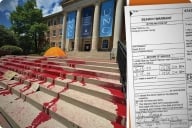You have /5 articles left.
Sign up for a free account or log in.
WASHINGTON -- Current practices in education research -- most of which is conducted in a university setting -- are insufficient to meet the demand for a better K-12 system, the new president of the Carnegie Foundation for the Advancement of Teaching says. In his first major policy address since becoming the foundation’s president, Anthony S. Bryk announced his vision for the future of education research and development at the American Enterprise Institute here Wednesday, putting particular emphasis on the possibility of reforming teacher education programs.
Byrk’s ideas concerning education research -- which he plans to present to the Carnegie Foundation’s board later this week for its consideration -- were born out of a chapter he wrote in The Future of Educational Entrepreneurship: Possibilities for School Reform (Harvard Education Press), a book of policy suggestions published in September.
A lack of financing is the largest problem facing education research, Bryk said, noting that less than 0.25 percent of the overall education budget -- an estimate based on education as a $500 billion a year industry in the United States -- is allocated to research and development. By contrast, he noted, in fields such as medicine and engineering, 5 to 15 percent of the total budget is spent on R&D.
Bryk expressed, moreover, concern that most research is being conducted in the university setting where, as he wrote, “new theory development is more valued than practical solutions.” This environment, he said, is not conducive to the creation of workable solutions in education reform -- not as long as scholarly articles in journals are considered the acme of accomplishment in educational research.
Additionally, Bryk said, on-the-ground teachers and policy makers tend to see this research as intended for other researchers, and irrelevant to their own everyday work. He said this is probably because teacher education programs and some research activities are viewed, and many times conducted, as separate from each other.
Any new vision of education research should be aligned with what its practitioners want, Bryk said.
“We must make schooling more efficient while simultaneously pressing forward toward more ambitious academic learning for all children,” Bryk said. “And, we need to accomplish all of this as the basic task has become more challenging given demographic changes, including the increasing numbers of English language learners.”
He noted that the problems of educational practice should be the problems of research’s inquiry. The primary goal of education research, he added, should be to “achieve greater reliability in [teacher and student] performance.”
The first step toward accomplishing this goal and revamping education research, Bryk said, is to reconsider the purpose of teacher training programs and to specify what teachers are expected to learn from this training. Still, if these to teacher preparation were made, he acknowledged, it would be difficult to determine how the reforms would affect an individual teacher's work in the classroom. He added further research would be needed to determine what refinements should be made.
Further, Bryk continued, any developments made in educational research need to pass a “learnability test” in order to determine whether it is possible for a critical mass of teachers to learn a specific skill or technique. This can be helped by the use of technology, he explained, but he cautioned that such technology should not used for its own sake.
In a suggestion that could shift the role of teacher education programs, Bryk proposed creating new roles for K-12 instructors in which more experienced teachers would lead “instructional teams” with younger colleagues. These senior teachers would then, in Bryk’s model, concentrate on their specialization while mentoring junior teachers who handle the remainder of the students. He added that these senior teachers would be key partners in educational research and development, gauging what was and was not working in the classroom.
Ultimately, Bryk said, it is the responsibility of professional schools to change the methods they use to train teachers for K-12 education and to improve the quality of the tools, materials and ideas with which they work to improve themselves and their students.
“The foundation might look at the role of the university and its relations to school districts and the commercial sector in developing people and the tools, materials and ideas that work,” Bryk stated in the official president’s message he wrote at the time of his arrival at the Carnegie Foundation. “The key question for us is one of valued added: How and where might introducing new tools and social practices advance the work of teachers, professors and other school professionals in improving student engagement and learning?”








